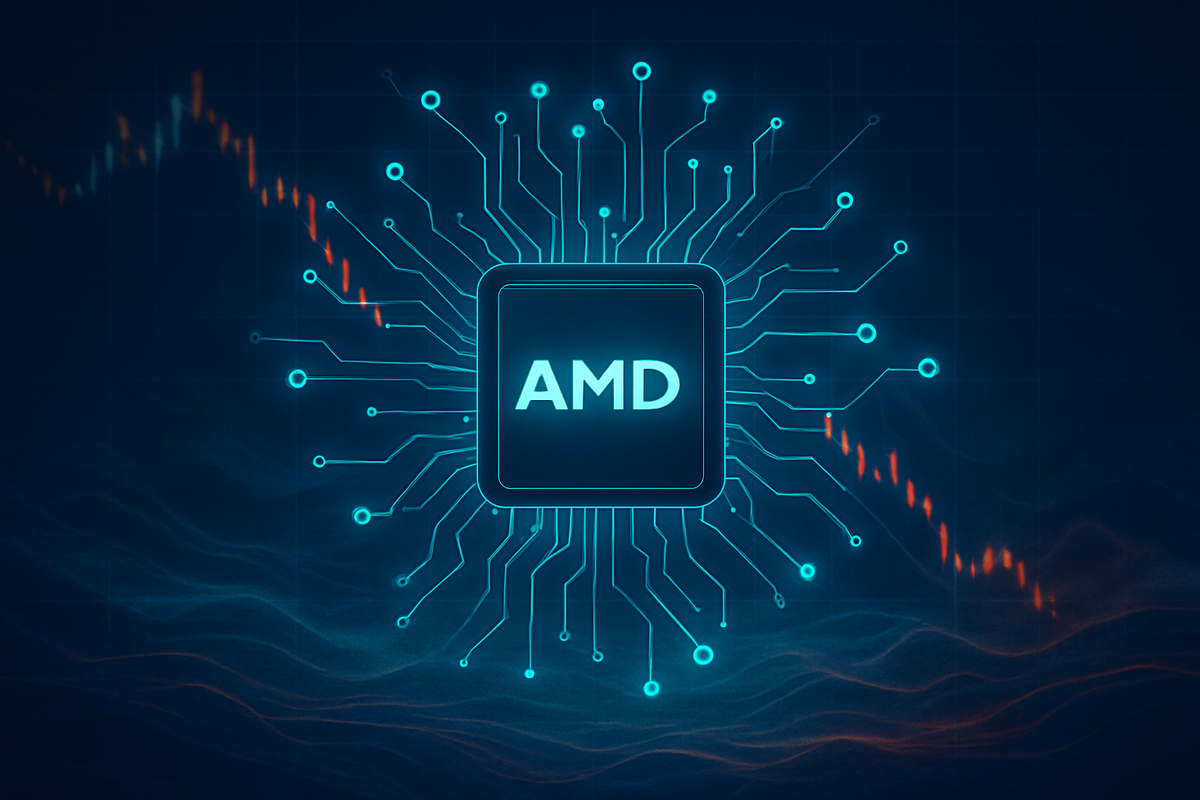
Advanced Micro Devices (NASDAQ: AMD) found itself in a precarious position on November 11, 2025, as its stock experienced a slight dip in pre-market trading, signaling underlying investor apprehension. This momentary hesitation came on the heels of a more significant 3.7% decline earlier in the month, following its robust third-quarter earnings report. While the semiconductor giant later rallied during its much-anticipated Financial Analyst Day, unveiling an ambitious roadmap for AI and data center dominance, the initial market jitters underscore persistent concerns regarding AMD's elevated valuation and the formidable execution challenges ahead in the fiercely competitive artificial intelligence landscape. The market appears to be grappling with whether AMD's aggressive growth projections are sustainable and if the company can truly deliver on its promises against a backdrop of intense competition and high investor expectations.
The immediate implications are a bifurcated market sentiment where optimism for AMD's long-term vision clashes with short-term skepticism over its ability to consistently outperform and justify its premium valuation. Investors are weighing the potential for groundbreaking AI advancements against the inherent risks of a demanding market and the shadow of established competitors. This creates a volatile environment for AMD shares, where even positive news can be met with profit-taking, highlighting the delicate balance between potential and peril for the chipmaker.
Undercurrents of Concern: Dissecting AMD's Recent Market Volatility
Despite a day that ultimately saw AMD's stock recover and even climb following its Financial Analyst Day on November 11, 2025, the journey to that point was marked by significant volatility and underlying concerns that continue to ripple through investor sentiment. The pre-market dip on the day itself, though minor, served as a fresh reminder of the market's cautious eye on the chipmaker. More notably, just a week prior, on November 5, 2025, AMD's shares experienced a more pronounced "crash" of 3.7%. This occurred despite the company reporting record third-quarter 2025 revenues of $9.25 billion, a 36% year-over-year increase, and non-GAAP earnings per share of $1.20, both exceeding analyst forecasts.
The primary driver behind this post-earnings decline was not a lack of performance, but rather a combination of profit-taking by investors and mounting concerns over AMD's already high valuation. After a year of significant gains, some investors opted to lock in profits, while others scrutinized the nuances of growth in the AI sector, demanding exceptional outperformance beyond mere headline figures to justify the stock's premium. Analysts have pointed to AMD's forward price-earnings ratio, hovering around 81.6x, as a potential indicator that much of the optimism surrounding its future growth might already be priced into the stock, leaving little room for error or disappointment.
The Financial Analyst Day, while largely positive in its outlook, also presented ambitious targets that come with inherent execution risks. CEO Lisa Su projected the AI data center market to reach $1 trillion by 2030, a significant jump from previous estimates, and detailed plans for next-generation MI400 series AI chips by 2026, followed by MI450 and MI500 series. While these announcements initially fueled a rally, some skepticism persists regarding AMD's ability to achieve a greater than 35% revenue compound annual growth rate (CAGR) and over $20 non-GAAP EPS within the next three to five years, especially in the face of intense competition from market leader Nvidia (NASDAQ: NVDA). The multi-year deal with OpenAI, announced in October, was indeed a significant win, but the market's reaction suggests that even "game-changing" developments are being met with a critical eye on the path to realization.
Winners and Losers: The High-Stakes Game of AI Dominance
The current dynamics surrounding AMD's stock performance highlight a critical juncture in the semiconductor industry, creating potential winners and losers based on the realization of ambitious AI strategies. For Advanced Micro Devices (NASDAQ: AMD) itself, the stakes are incredibly high. If the company successfully executes its aggressive product roadmap for the MI series of AI chips, delivers on its projected $1 trillion AI data center market opportunity, and achieves its financial targets of over 35% revenue CAGR and $20+ non-GAAP EPS, it stands to solidify its position as a formidable challenger to Nvidia. However, any missteps in product development, delays in market penetration, or failure to capture significant market share could lead to investor disappointment, further valuation corrections, and a sustained negative performance of its stock. The initial dips, despite strong earnings and bullish projections, indicate that the market is highly sensitive to the gap between promise and delivery for AMD.
On the other side of the coin, Nvidia (NASDAQ: NVDA), the current undisputed leader in AI accelerators, stands to gain significantly from any perceived weakness or execution challenges faced by AMD. Nvidia's established ecosystem, robust market share, and continuous innovation in AI hardware and software provide it with a strong competitive moat. Should AMD struggle to ramp up its MI series production, or if its performance-per-dollar proposition fails to significantly undercut Nvidia, the latter could further consolidate its market dominance. This dynamic creates a "winner-take-most" scenario where even minor stumbles by one player can lead to substantial gains for the other, especially in the rapidly expanding but intensely competitive AI market.
Beyond the direct rivals, other players in the semiconductor and cloud computing sectors could also be impacted. Companies like Intel (NASDAQ: INTC), while currently lagging in the high-end AI accelerator market, could see opportunities to gain traction if the market perceives a duopoly of AMD and Nvidia as too concentrated or if customers seek diversified supply chains. Furthermore, major cloud providers such as Oracle Cloud Infrastructure (NYSE: ORCL), which are already deploying AMD's MI350 Series GPUs, have a vested interest in AMD's success. Their continued investment and reliance on AMD's technology could be a significant endorsement, but conversely, any performance issues or supply chain disruptions from AMD could force them to diversify their AI infrastructure, potentially benefiting other chip providers. The entire ecosystem is watching closely, as the success or failure of AMD's ambitious AI push will undoubtedly reshape the competitive landscape for years to come.
Wider Significance: The AI Race, Valuation Bubble, and Market Sensitivity
The recent market behavior surrounding AMD is more than just a fluctuation for a single stock; it's a microcosm of broader industry trends and anxieties gripping the technology and financial markets. The intense focus on AMD's AI roadmap and its projected growth figures highlights the ongoing, high-stakes "AI race" that dominates the semiconductor industry. Every announcement, every product launch, and every market share gain or loss is scrutinized for its implications on who will ultimately lead the charge in this transformative technology. AMD's aggressive targets, while inspiring, also underscore the immense pressure on all players to innovate relentlessly and capture a slice of the rapidly expanding AI total addressable market (TAM).
This event also brings into sharp relief the persistent concerns about a potential "valuation bubble" in the tech sector, particularly among companies heavily invested in AI. With AMD trading at a forward P/E ratio exceeding 80x, investors are clearly baking in substantial future growth. This elevated valuation makes these stocks highly sensitive to any hint of underperformance, missed targets, or increased competition. The post-earnings dip for AMD, despite strong results, serves as a potent reminder that even stellar growth might not be enough to satisfy an already sky-high valuation, triggering profit-taking and a re-evaluation of risk. This sensitivity could trigger ripple effects across the broader market, as investors become more cautious about other high-flying tech stocks with similar valuation metrics.
Furthermore, the competition between AMD and Nvidia (NASDAQ: NVDA) is not just a corporate rivalry; it has significant implications for technological innovation and market dynamics. Should AMD falter in its execution, it could slow down the pace of competitive innovation, potentially leading to a more concentrated market and fewer choices for consumers and businesses relying on AI hardware. Conversely, AMD's success in challenging Nvidia could drive down costs, accelerate technological advancements, and foster a healthier competitive environment. Regulatory bodies might also begin to pay closer attention if one player appears to be gaining an insurmountable lead, potentially leading to antitrust scrutiny, although this is a long-term prospect. Historically, similar battles for technological dominance, such as the CPU wars between Intel (NASDAQ: INTC) and AMD, have shaped the industry for decades, and the AI accelerator market is poised for a similar, if not more intense, showdown.
What Comes Next: Navigating the Crossroads of Ambition and Execution
The path forward for AMD (NASDAQ: AMD) is a tightrope walk between ambitious projections and the formidable challenges of execution in a hyper-competitive market. In the short term, investors will be keenly watching the company's progress in ramping up production and securing design wins for its MI300 series GPUs, particularly the MI350. Any signs of delays, production bottlenecks, or less-than-stellar performance compared to competitors could trigger renewed selling pressure and dampen the positive sentiment generated by the Financial Analyst Day. Quarterly earnings reports and subsequent guidance will be critical checkpoints, offering insights into the tangible progress of its AI initiatives and whether the company is on track to meet its aggressive revenue and EPS targets.
Looking further ahead, the long-term trajectory for AMD hinges on its ability to successfully launch and scale its next-generation MI400 and MI500 series AI chips in 2026 and 2027, respectively. This involves not only delivering cutting-edge hardware but also building a robust software ecosystem and fostering strong developer support to rival Nvidia's (NASDAQ: NVDA) CUDA platform. Potential strategic pivots might include increased partnerships with cloud service providers and enterprise customers to ensure broad adoption, or even targeted acquisitions to bolster its software capabilities or supply chain resilience. The market opportunities are immense, but so are the challenges, including managing supply chain complexities, navigating geopolitical tensions affecting semiconductor manufacturing, and fending off continuous innovation from rivals.
Several scenarios could unfold. In a bullish scenario, AMD flawlessly executes its roadmap, gains significant market share in the AI data center segment, and consistently exceeds financial expectations, leading to sustained stock appreciation. Conversely, a bearish scenario could see the company struggling with execution, facing stronger-than-anticipated competition, or failing to justify its high valuation, resulting in a significant correction in its stock price. A more neutral outcome might involve AMD achieving moderate success, carving out a niche, but not fully realizing its most ambitious projections, leading to more modest stock growth. Investors should brace for continued volatility as AMD navigates these critical years, with each development offering a clearer picture of its ultimate fate in the AI revolution.
Comprehensive Wrap-up: A High-Stakes Bet on the Future of AI
The recent events surrounding Advanced Micro Devices (NASDAQ: AMD) encapsulate the exhilarating promise and inherent risks of investing in the rapidly evolving artificial intelligence landscape. While AMD’s Financial Analyst Day on November 11, 2025, painted a compelling picture of future dominance in AI and data centers, the preceding market jitters and the post-earnings "crash" served as crucial reminders of the market’s discerning eye on valuation and execution. The key takeaway is that despite ambitious projections and strong underlying technological capabilities, AMD faces an uphill battle to consistently justify its premium valuation and deliver on its aggressive growth targets amidst fierce competition from the likes of Nvidia (NASDAQ: NVDA).
Moving forward, the market will assess AMD not just on its vision, but on its tangible progress. The coming months will be critical for demonstrating robust execution in its AI chip roadmap, securing significant design wins, and translating its technological prowess into substantial revenue and profit growth. Investors should closely monitor AMD's quarterly earnings reports for signs of progress in its data center segment, the adoption rate of its MI series GPUs, and any updates regarding its ambitious financial targets. Furthermore, keeping an eye on the competitive landscape, particularly Nvidia's responses and any new entrants, will be vital for understanding the broader market dynamics.
Ultimately, AMD's journey represents a high-stakes bet on the future of AI. Its ability to navigate the complexities of product development, market penetration, and fierce competition will determine whether it can transform its potential into sustained market leadership or if its current valuation will prove to be an insurmountable hurdle. The lasting impact of these events will be measured by AMD's capacity to convert its strategic vision into concrete results, making it a compelling, albeit risky, stock to watch in the coming months.
This content is intended for informational purposes only and is not financial advice





